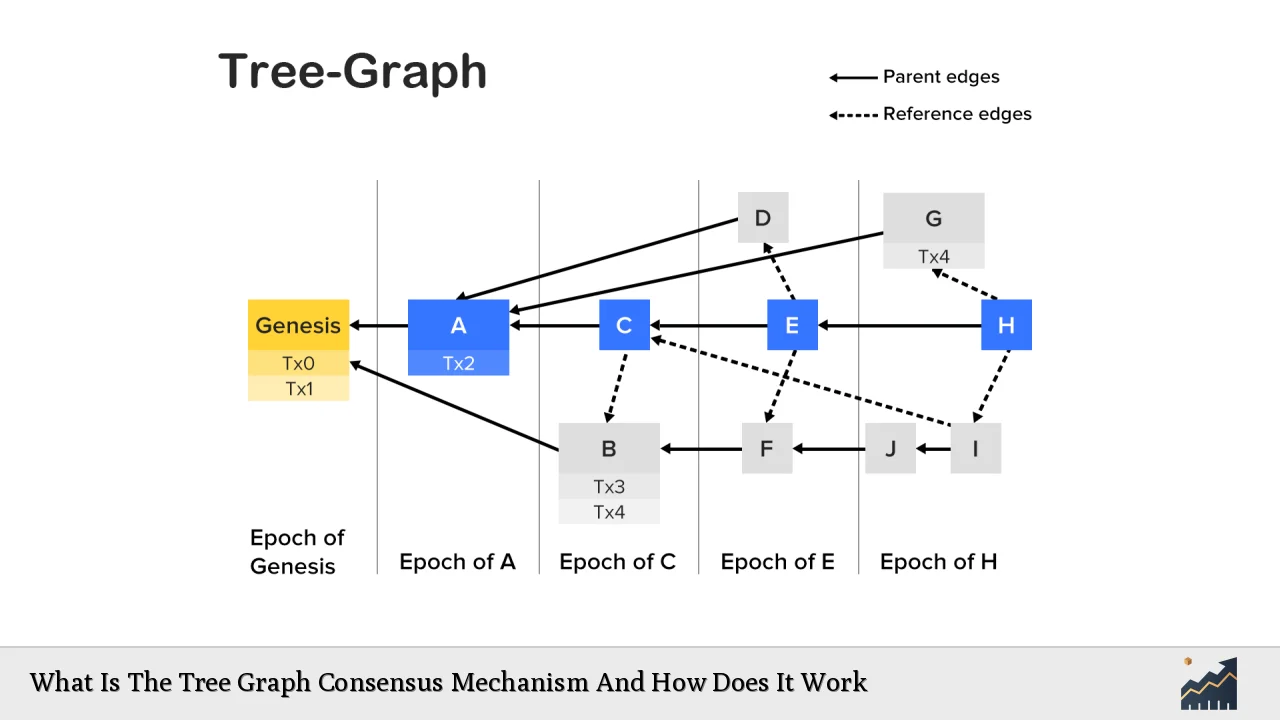The Tree Graph consensus mechanism is an innovative approach to achieving consensus in blockchain networks, primarily implemented by the Conflux network. This mechanism addresses significant challenges faced by traditional blockchains, such as scalability and security, by allowing for high throughput and efficient transaction processing. Unlike conventional systems that rely on a single chain of blocks, the Tree Graph integrates multiple blocks simultaneously, creating a structure that enhances both performance and decentralization.
The Tree Graph combines aspects of both Proof of Work (PoW) and Proof of Stake (PoS) to ensure that the network remains secure while also enabling rapid transaction validation. By utilizing a unique ledger structure and a specialized chain selection rule known as GHAST, the Tree Graph can process transactions more efficiently than traditional blockchain models.
| Key Concept | Description/Impact |
|---|---|
| Tree-Graph Structure | Combines features of directed acyclic graphs (DAG) and trees, allowing multiple blocks to coexist and be processed concurrently. |
| GHAST Rule | Enables selection of forks based on mining power rather than chain length, improving security and performance. |
| Hybrid Consensus | Integrates PoW for block creation and PoS for finality, balancing decentralization with efficiency. |
| High Throughput | Can achieve block creation rates of up to 2 blocks per second, significantly enhancing transaction speeds compared to traditional blockchains. |
| Adaptive Difficulty Adjustment | Dynamically adjusts mining difficulty based on network conditions to maintain stability and miner profitability. |
| Decentralization | Encourages independent decision-making among nodes, reducing the risk of network manipulation. |
Market Analysis and Trends
The demand for scalable blockchain solutions has surged as industries increasingly adopt decentralized technologies. The Tree Graph consensus mechanism positions itself as a viable alternative to traditional systems like Bitcoin and Ethereum, which struggle with scalability due to their reliance on linear blockchains.
Recent market statistics indicate a growing interest in Layer-1 solutions that offer enhanced performance. For instance, the Conflux network has seen its market capitalization reach approximately $1.02 billion as of December 2024, with a trading volume of around $123.98 million over the last 24 hours. This growth reflects a broader trend where investors are seeking platforms that can handle high transaction volumes without sacrificing security or decentralization.
Current Trends
- Increased Adoption: More projects are exploring hybrid consensus mechanisms to balance efficiency and security.
- Focus on Scalability: As user demand grows, blockchain networks are prioritizing solutions that allow for faster transaction processing.
- Investment in Layer-1 Solutions: Investors are increasingly funding projects like Conflux that promise innovative consensus mechanisms capable of handling real-world applications.
Implementation Strategies
To effectively implement the Tree Graph consensus mechanism, developers must consider several key strategies:
- Node Independence: Encourage nodes to operate independently in selecting parent blocks to enhance decentralization.
- Adaptive Algorithms: Utilize adaptive difficulty adjustment algorithms that respond to real-time network conditions to optimize block generation rates.
- Integration with Existing Systems: Ensure compatibility with existing blockchain infrastructures to facilitate smoother transitions for projects migrating from traditional systems.
Steps for Implementation
- Design the Ledger Structure: Develop the Tree Graph structure that allows for concurrent block processing.
- Develop the GHAST Algorithm: Implement the GHAST chain selection rule to enhance fork selection based on mining power.
- Combine PoW and PoS: Create a hybrid model where PoW miners produce blocks while PoS validators confirm transactions.
- Test Network Stability: Conduct extensive testing under various load conditions to ensure stability and security before full deployment.
Risk Considerations
While the Tree Graph consensus mechanism offers numerous advantages, it is essential to acknowledge potential risks:
- Network Attacks: Despite its design for robustness against attacks, vulnerabilities may still exist if a significant portion of nodes collude or behave maliciously.
- Complexity in Implementation: The dual-layer structure may introduce complexity in development and maintenance, requiring skilled developers familiar with both PoW and PoS protocols.
- Market Volatility: As with any cryptocurrency project, market fluctuations can impact investment viability and user confidence in the network’s stability.
Regulatory Aspects
As blockchain technology continues to evolve, regulatory scrutiny is increasing. The implementation of the Tree Graph consensus mechanism must comply with local regulations regarding cryptocurrency operations:
- Compliance with Securities Laws: Projects must ensure that their tokens do not classify as securities unless properly registered or exempted under applicable laws.
- Data Privacy Regulations: Adhering to regulations such as GDPR is crucial when handling user data within decentralized applications built on the Tree Graph framework.
- Anti-Money Laundering (AML): Implementing robust AML practices will be necessary to prevent illicit activities within the network.
Future Outlook
The future of the Tree Graph consensus mechanism appears promising as demand for scalable blockchain solutions continues to rise. Key factors influencing its trajectory include:
- Technological Advancements: Ongoing research into consensus mechanisms may lead to further optimizations in speed and security.
- Increased Adoption by Enterprises: As businesses recognize the benefits of decentralized technologies, adoption rates are likely to increase significantly.
- Interoperability with Other Blockchains: Enhancing compatibility with other blockchain networks could broaden its use cases and market appeal.
Overall, as industries seek efficient solutions for their decentralized applications, mechanisms like Tree Graph will play a crucial role in shaping the future landscape of blockchain technology.
Frequently Asked Questions About The Tree Graph Consensus Mechanism
- What is the main advantage of the Tree Graph consensus mechanism?
The primary advantage is its ability to achieve high throughput by allowing multiple blocks to be processed simultaneously while maintaining decentralization. - How does the GHAST algorithm work?
The GHAST algorithm selects forks based on mining power working on their subtree rather than just chain length, enhancing security against certain types of attacks. - Can Tree Graph be integrated with existing blockchains?
Yes, it can be designed to be compatible with existing infrastructures, facilitating easier transitions for projects looking to upgrade their systems. - What are the risks associated with using this consensus mechanism?
Risks include potential network attacks from colluding nodes, complexity in implementation, and market volatility affecting user confidence. - Is regulatory compliance necessary for projects using Tree Graph?
Yes, compliance with local laws regarding securities, data privacy, and anti-money laundering is essential for successful operation. - What industries can benefit from this technology?
A variety of industries including finance, supply chain management, and healthcare can benefit from the scalability and efficiency offered by Tree Graph. - How does adaptive difficulty adjustment work?
This feature dynamically changes mining difficulty based on recent block generation speeds to maintain network stability and miner profitability. - What is the future potential of the Tree Graph consensus mechanism?
The future looks bright as demand for scalable blockchain solutions increases; ongoing technological advancements will likely enhance its capabilities further.

